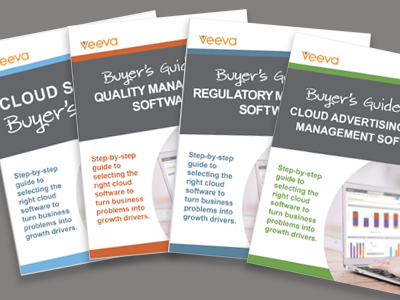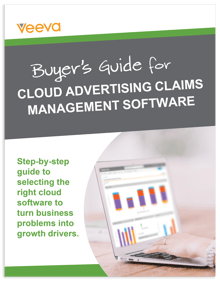Whether you’ve been advocating for digital transformation for years, or 2020 generated new urgency, many organizations like yours are including digital infrastructure upgrades like investing in cloud-based software in their 2021 budgets.
Gartner predicts that worldwide end-user spending on public cloud services is forecast to grow 18.4% in 2021 to total $304.9 billion, up from $257.5 billion in 2020.“The pandemic validated cloud’s value proposition,” said Sid Nag, research vice president at Gartner. “The ability to use on-demand, scalable cloud models to achieve cost efficiency and business continuity is providing the impetus for organizations to rapidly accelerate their digital business transformation plans. The increased use of public cloud services has reinforced cloud adoption to be the ‘new normal,’ now more than ever.”
With this in mind, we’ve collected 5 best practices from our Cloud Software Buyer’s Guide eBook collection - including editions tailored to Quality, Regulatory, and Advertising Claims - to help you make the strongest case within your organization for investing in modern software solutions to achieve your digital transformation.
#1 Form a (Small) Working Group to Represent Key Perspectives
As tempting as it may be to just go at it alone gathering information and then building your business case, we highly recommend enrolling select stakeholders in this effort from the beginning to ensure you are incorporating multiple perspectives.
We’ve found this to be the ideal mix:
- Business Process Owner
- Business User Representative
- IT Business Partner
- Business Buyer Representative
This group is charged with identifying and quantifying the most pressing business problems within your chosen scope, and then exploring opportunities to address them. For more on this best practice, we encourage you to review Chapter 2 of the Buyer’s Guide series.
#2 Use Clear Criteria to Identify Urgent, Impactful, and High Potential Business Problems
For most of us, it’s not so simple to pin down what makes a business process or relationship painful or inefficient. Maybe market or business norms slowly evolved until how you are working just doesn’t “work” anymore. Maybe over the years, well-meaning people slowly added new reporting steps or stakeholders to a process, and the build up of “corporate cholesterol” has left you at risk for an aneurysm.
However your department or organization got to its current state, it’s time to reclaim your (work)life by identifying business problems that have the potential to free up significant time for more strategic activities.
For the best chance of successfully securing funding and implementing a new system - such as a cloud-based regulatory management system or an eQMS - we recommend focusing on a process or system problem that appears:
- Urgent
- Impactful to the business
- Potential to generate early “quick wins” and positive ROI
Here are two examples of use cases that illustrate a quantifiable business problem:
| Example: The quality manager receives 20 new complaints weekly. This process involves 3-4 other employees, and approximately 6 steps in 4 different systems including sifting through paper batch records. Total employee time: 3-5 hours per complaint. | Example: The regulatory affairs coordinator manages 50 product dossiers per month. This process involves 5-6 other employees, and approximately 12 steps in 5 different systems. Total employee time: 40-60 hours. |
For more on this best practice, we encourage you to review Chapter 2 of the Buyer’s Guide series.
#3 Take the Time to Develop a Compelling Business Case
Developing a cloud business case is critical to achieving cross-stakeholder alignment and support for your strategy, as well as the overall success of your initiative. In our experience, a cloud business case is a written document or presentation with five essential sections:
- Current state
- Business and industry environment
- What’s at stake
- Vision for future
- Strategy to achieve vision
This format for a cloud business case ensures that the right people have a shared understanding of how this initiative gets them from the current state to the future state, and what is at stake if they do not change.
This may seem like a lot of work, but trust us, it’s an essential step. Without alignment around all five of these areas from the beginning, you are leaving openings for new people to poke holes in or derail your strategy later on, putting the whole initiative at risk.
See how to build a powerful business case with step by step guidance and templates in Chapter 3 of the Buyer’s Guide series.
#4 Start Small to Prove Concept, then Build on Successes
We recommend avoiding outdated “waterfall” projects that run the risk of trying to do too much at once and accomplishing nothing.
Instead, work with agility to quickly spin up a pilot with a focus on achieving quick wins, and then use the momentum and learnings to expand on what works.
- Outline criteria for prioritizing use cases
- Define the scope of a pilot program to solve the top one to two use cases in 2-3 months (not several years)
- Assuming success, lay out how you’d expand on the pilot to address other use cases and eventually transform the full business problem area
- Recommend the stakeholders you believe will need to be involved to make this initiative successful
Not sure what a quick win project could look like at your organization? Contact one of our specialists to hear about projects that your industry peers have found success with.
#5 Look for a Trusted Technology Partner, Not a Vendor
We recommend approaching software evaluations like you are interviewing a potential employee. This shouldn’t just be some vendor you buy from and don’t hear from again until it’s time to renew. You want (and deserve) a strategic partner who will take the time to understand your industry and your organization and put in the effort to actively make things better.
So look at their past successes and strategic investments. Get references, ideally blind. Ask the right questions to expose the weaknesses of vendors who might appear strong on paper, but don’t match up on a real-world use case or work with the agility and speed required to realize your vision and strategy. As many of us have learned the hard way, making a “bad hire” is more costly than doing sufficient due diligence.
Learn more about vendor evaluation and selection best practices, including suggested criteria and referral methods in Chapter 4 of the Buyer’s Guide series.
Are you ready to get started advocating for an upgrade to modern software solutions for your business area? Download one of our free ebooks now or contact one of our specialists to discover your best next step.
|
Cloud Software |
Buyer's Guide for Cloud |
Buyer's Guide for Cloud Regulatory Management Software |
Buyer's Guide for Cloud Advertising Claims |
SHARE













